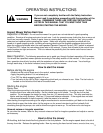
6
Operation In Reverse
Keep both feet on the foot platform at all times.
Look behind you before backing to prevent
injuring yourself or anyone behind you. Operate
the mower very slowly, inching it backward until
you become familiar with how the mower
operates. Always operate slowly if in an awkward
location or position. While backing up never place
your foot or feet near the wheels or the mower
deck to prevent serious personal injury. The
control system is equipped with a return to neutral
from reverse spring. This is to aid the operator in
returning the mower to neutral after a reverse
maneuver.
Zero-Radius Turn Operation
During zero-radius turns (when one mower wheel
rotates backwards while the other rotates forward)
drive extra slowly to reduce the possibility of
losing traction, or control, or becoming dizzy. This
will help prevent you from being thrown off the
mower or into the control levers. Be aware that if
you do a turn on a slope you may go through all of
the orientations to a slope mentioned below and
must handle the mower accordingly.
Operation on Slopes
DO NOT operate on steep slopes. Do not
operate the mower on slopes steeper than you
can feel secure about the traction of the tires and
the stability of the mower. Do not operate the
mower on slopes at all when the grass is wet.
There is a danger of suddenly sliding sideways or
down the hill. When operating on a slope, travel
across the grade whenever possible, not in an up
or down pattern. Reduce speed and exercise
extreme caution on slopes and in sharp turns to
prevent tipping or loss of control. Be especially
cautious when changing direction on slopes.
When pointing up a slope, your mower has the
most weight on the drive wheels and therefore the
most traction at the tires. However, this is the
angle that it has the most tendency to tip back
(“pop a wheelie.”) This is the preferred angle for
mowing small areas of steeper slopes.
WARNING
Recommendations for this angle:
• Lean as far forward as possible to shift your
weight to the front of the mower.
• Accelerate gently. Do not accelerate quickly to
avoid “popping a wheelie”.
• If backing down the hill, do not stop suddenly
but slow down gradually.
When pointing down a slope, your mower has
the least weight on the rear drive wheels and
therefore the least traction at the tires. This is the
angle that the mower has the most tendency to
slide. However, this is the angle that it has the
least tendency to tip back. Avoid this angle, as it
has the least advantage for your mower.
WARNING
Recommendations for this angle:
• Sit back as far as you can on the seat. This
adds more of your body weight to the drive
wheels for more traction.
• Do not change speed suddenly to minimize the
tendency of going into a slide. Accelerate
and decelerate gently. If you ever go into an
uncontrolled slide while pointing down a
slope the recommended procedure is to let
go of the handles and jump off if necessary.
Otherwise, control the mower gently and
stay off slopes that tend to make the wheels
slide.
WARNING
When crossing a slope sideways, your mower
has the average amount of weight on the drive
wheels versus the front wheels, similar to level
ground. However, this angle leaves the least
weight on the higher side drive wheel, tending to
make it slip. This is the preferred angle for
mowing large areas of gentle slopes.
Recommendations for this angle:
• Sit back, as far as you can on the seat. This
adds weight to the rear drive wheels and will
allow you to mow more quickly across the
slope without sliding. Remember it is
recommended that operators weigh at least
120 pounds and not more than 300 pounds.
These are general guidelines only. The
mower function and comfort will vary


















